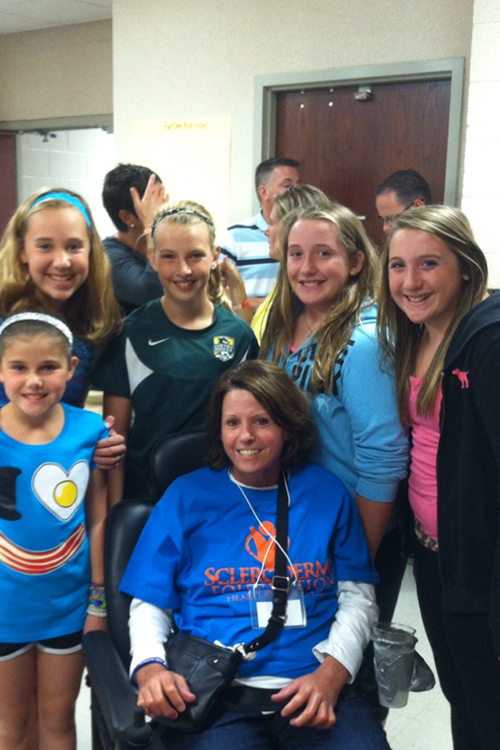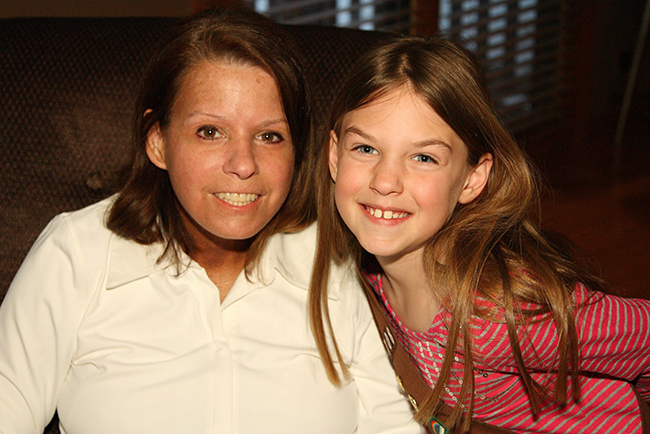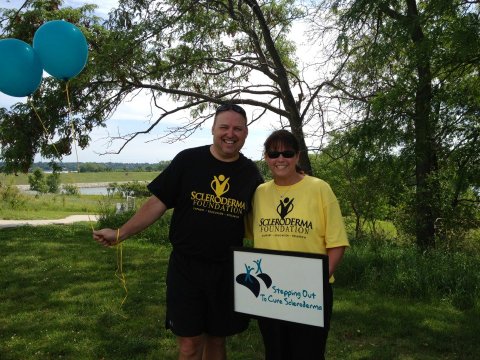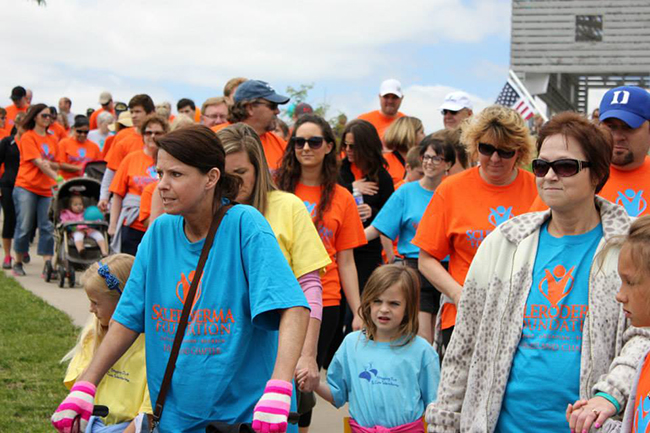|
From the Heartland: Jackie Latka In My Own Words By Jackie Latka as told to Christina Relacion
My scleroderma story started in April 2011. I would wake up in the early morning and my hands would be asleep. It was a strange feeling that would wake me up. I noticed some swelling in my hands and I had to put them in the air to make it go away. I thought I had carpal tunnel, so I went to the doctor. About a month or so later, I was in the shower and noticed that my elbows, ankles, feet and knees were swollen. I saw the doctor and a nurse practitioner and they suggested that I change to a low sodium diet to see if the swelling would go down. By the time I saw the doctor again in August 2011, she exclaimed, “You’re so swollen!” I had swelling all the way up my arms and legs. My socks left indents on my skin. The doctor put me on steroids, and instantly I went almost back to normal except for my hands. We tried tapering off the medications but I kept coming back to ask for more. Finally, she said, “You have an autoimmune disease,” and sent me to my first specialist. When I saw the rheumatologist for the first time, she said that I had scleroderma, and she asked, “Do you know what it is?” I said, “I do.” I’m a Lifetime movie fan, and I remember watching these movies with my roommates years ago. There was one film called “For Hope” [1] that we watched. This was years and years ago, but it made such a huge impact on me. I remembered this poor women had scleroderma. She died. By August 2012, I was frequently out of breath. My doctor sent me to a pulmonologist who confirmed that I have interstitial lung disease (ILD) and borderline pulmonary hypertension. My condition has continually gone downhill during the past year. My skin has become harder. I haven’t been able to go up the stairs in our two-story house since February 2013. Because of my lack of mobility, I went on disability in November 2012. In the last six to nine months, this disease has really taken a lot from me and crippled my body. I use a walker to go places. I can’t drive myself. Sometimes I need a wheelchair.
I saw Dr. Maureen Mayes in Houston, and she said I needed to have a stem cell transplant [2]. Dr. Mayes had come highly recommended and she had seen other patients with scleroderma from Omaha. For her to tell me to have a stem cell transplant during our first meeting meant a lot. I’ve talked to several people who have undergone a transplant, and they report that it can be a life-changing experience. I’ve watched videos of some people who have had a stem cell transplants. They can ride horses and own construction companies. I can’t even go see my 9-year-old daughter’s soccer or volleyball games because it’s so hard. To see a person gain their independence back is a big thing. I want my quality of life back. Some people say their hands don’t come back exactly to normal. I could live with that, but I need to be independent. Currently, I’m trying to get my insurance to approve the treatment. I’ve worked with the team at MD Anderson in Texas. We’re on the second appeal with the insurance company. The hospital said that my husband and I need to pre-pay a minimum of $458,000 for the procedure. One injection alone costs $60,000. I knew my insurance wasn’t going to go for it. If we don’t win this appeal, we’ll probably hire a lawyer to fight the insurance so that they will approve it. Our family and friends hosted a benefit in September to help with the costs of the treatment in Houston.
My family’s reaction has been good. My daughter Scout does and doesn’t understand scleroderma. She participates in the Omaha walk, but she sees it more as fun. She said to me, “Mom, I love that you have scleroderma because you’re home more and we get to spend time together.” I replied to her, “Right, that’s great, but I also want to come to your games and events.” She says that’s OK. One day she asked me if I was going to die from this disease. I said, “I don’t know.” My husband Jim has taken on all the responsibilities of getting Scout to school and sports. He volunteers for Girl Scout functions because I can’t do it anymore. It has become a normal part of our life and we have come to accept that I need help. I look at this as a plan for my life. I want to accept this and turn this into something helpful. We do this by not focusing on the negative and turning it into something positive. The support of the rest of my family has been overwhelming. As my condition went downhill, and family members noticed the difference in me from just six months before, it struck a chord with them. The response by people who came out and walked in my honor this year was just amazing. So many people have come to help me, Jim and Scout. They do anything we ask of them. It’s truly amazing. This ye, we raised more than $6,000 at the walk.
Scleroderma has come to change my life and perspective of things, like things I took for granted before; the people who have reached out and those who I never thought would; or those who I thought would reach out and haven’t. When I meet people, I let them touch my hands and feel how hard my skin is. People watch how difficult it is for me to get up and they see the toll that it has taken on my body. It’s a huge thing to get people to understand this disease. In “The Scleroderma Book: A Guide for Patients and Families,” Dr. Mayes compares scleroderma to retiring and other life-changing events. There are people who will move along with you, and there are people who will resent you because you have changed. Relationships will change, and I’m OK with that. I want to focus on the amazing amount of people who have come forward to help my family and me.
At the Heartland Chapter’s walk in Omaha in June 2013 |
|
|
||||
Back
Understanding Scleroderma
Back
Treating Scleroderma
Back
Living Well with Scleroderma
Back
Advancing Research and Treatment
Back
Get Involved



 In September 2013,
Jackie’s family and friends hosted a fundraising event to defray costs of the
stem cell transplant she needs. (This event was not affiliated in any way with
the Scleroderma Foundation or the Heartland Chapter.) With Jackie in the photo
are (from left to right): Abbie Woelber, Ellie Nosal, Chloe Ekborg, Ryleigh
Warren and Madi Warren. The group of girls made and sold bracelets to help.
In September 2013,
Jackie’s family and friends hosted a fundraising event to defray costs of the
stem cell transplant she needs. (This event was not affiliated in any way with
the Scleroderma Foundation or the Heartland Chapter.) With Jackie in the photo
are (from left to right): Abbie Woelber, Ellie Nosal, Chloe Ekborg, Ryleigh
Warren and Madi Warren. The group of girls made and sold bracelets to help.

